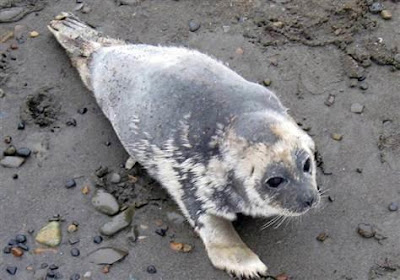カナダ医師会の公式雑誌、「カナダ医師会ジャーナル Canadian Medical Association Journal (CMAJ)」はピア・レビューの科学雑誌です。そこに、12月21日付けで、「冷温停止」を宣言した日本政府を厳しく批判する記事が載りました。
曰く、
と、一言で言えば、「ぼろくそ」の批判です。機会がある毎に日本政府を褒めちぎる某国際機関とは大違い。上記の2点目は、実際IRCPの勧告違反でもあります。
更に、日本公衆衛生協会の多田羅浩三博士の11月の米国での発表を引用し、
「[政府の設定した被曝]レベルが大丈夫だ、と人々を説得するのは、大変に難しい」
と日本政府の本音もちらつかせたあと、冷温停止状態宣言された現在でも
「現時点では、長期にわたる健康被害を最小限にするための一番大事な公衆衛生上の方策は、避難区域を広げることだ。」
と専門家の言を引用しています。避難は今からでも少しも遅くないようです。
以下、記事大急ぎ私訳。(大筋は間違ってないはずです。)
元の英文記事はこちら。原題の"public health fallout"は、言うまでもなく「放射性降下物(死の灰)」、Radioactive falloutに掛けていますね。日本語では別の言葉になってしまいましたが。
======================================
Public health fallout from Japanese quake
Lauren Vogel CMAJ
December 21, 2011
日本の震災が公衆衛生に及ぼした副次的影響
CMAJ ローレン・ヴォーゲル
2011年12月21日
A “culture of coverup” and inadequate cleanup efforts have combined to leave Japanese people exposed to “unconscionable” health risks nine months after last year’s meltdown of nuclear reactors at the Fukushima Dai-ichi power plant, health experts say.
「隠蔽の文化」と不十分な除染が相まって、福島第一原発の原子炉メルトダウンから9ヶ月経った今、日本人は「人倫にもとる」健康リスクにさらされている、と専門家らは言う。
Although the Japanese government has declared the plant virtually stable, some experts are calling for evacuation of people from a wider area, which they say is contaminated with radioactive fallout.
福島原発は事実上安定していると日本政府が宣言しているものの、死の灰がより広い範囲を汚染しておりそこから人々を避難させるべきである、とする専門家もいる。
They’re also calling for the Japanese government to reinstate internationally-approved radiation exposure limits for members of the public and are slagging government officials for “extreme lack of transparent, timely and comprehensive communication.”
彼らはまた、国際的に承認された公衆の放射線被曝限度に戻すよう日本政府に求め、「透明でタイムリーで包括的な情報の伝達が極度に欠如している」、と酷評している。。
But temperatures inside the Fukushima power station's three melted cores have achieved a “cold shutdown condition,” while the release of radioactive materials is “under control,” according to the International Atomic Energy Agency (www.iaea.org/newscenter/news/2011/coldshutdown.html). That means government may soon allow some of the more than 100 000 evacuees from the area around the plant to return to their homes. They were evacuated from the region after it was struck with an 8.9 magnitude earthquake and a tsunami last March 11.
しかし、福島原発の3つの溶けた炉心の温度は「冷温停止状態」を達成、放射性物質の漏洩も「制御されている」、と国際原子力機関(IAEA)は言う。これは、日本政府がまもなく原発周辺地域から避難した10万人以上の住民の一部の帰還を許すかもしれない、ということを意味する。住民は3月11日、マグニチュード8.9[実際は9.0に気象庁が訂正]の地震と津波が地域を襲ったあと、避難した。
Although the potential for further explosions with substantial releases of radioactivity into the atmosphere is certainly reduced, the plant is still badly damaged and leaking radiation, says Tilman Ruff, chair of the Medical Association for Prevention of Nuclear War, who visited the Fukushima prefecture in August. “There are major issues of contamination on the site. Aftershocks have been continuing and are expected to continue for many months, and some of those are quite large, potentially causing further damage to structures that are already unstable and weakened. And we know that there’s about 120 000 tons of highly contaminated water in the base of the plant, and there’s been significant and ongoing leakage into the ocean.”
これ以上の爆発で放射能の大気中への大量拡散が起こる可能性は確かに減少している。しかし、原発が激しく損傷しており放射能が漏出していることには変わりはない、とティルマン・ラフは言う。ラフは『核戦争防止医学協会(Medical Association for Prevention of Nuclear War)』の会長で、福島県を8月に訪れている。「現場の放射能汚染は大きな問題です。余震は続いており、今後何ヶ月も続くことが予想されていて、そのうちのいくつかは非常に大きく、既に不安定で弱った構造物に更にダメージを与える可能性もあります。原発の地階には約12万トンの高度汚染水が溜まっており、相当量の海への漏出が起きている。」
The full extent of contamination across the country is even less clear, says Ira Hefland, a member of the board of directors for Physicians for Social Responsibility. “We still don't know exactly what radiation doses people were exposed to [in the immediate aftermath of the disaster] or what ongoing doses people are being exposed to. Most of the information we're getting at this point is a series of contradictory statements where the government assures the people that everything's okay and private citizens doing their own radiation monitoring come up with higher readings than the government says they should be finding.”
国土の汚染の程度は更に不明だ、と言うのは『社会的責任を果たすための医師団』の役員の一人、イラ・ヘフランド。「人々が[原発事故直後に]どれほどの被曝にさらされたのか、引き続いてどれくらいの被曝をしているのか、私たちには未だにはっきり分からないのです。現時点で得ている情報の大半は矛盾したもので、一方では政府が何も問題はない、と国民を安心させ、もう一方では市民が自分たちで放射線測定をして、政府が発表する数値より高い数値を計測している、という具合です。」
Japanese officials in Tokyo have documented elevated levels of cesium — a radioactive material with a half-life of 30 years that can cause leukemia and other cancers — more than 200 kilometres away from the plant, equal to the levels in the 20 kilometre exclusion zone, says Robert Gould, another member of the board of directors for Physicians for Social Responsibility.
福島原発から200キロ以上離れた東京で、政府は高いレベルのセシウムを検出している、とロバート・グールドは言う。セシウムは半減期が30年の放射性物質で、白血病やその他のがんを引き起こす可能性がある。グールドも『社会的責任を果たすための医師団』の役員の一人だ。
International authorities have urged Japan to expand the exclusion zone around the plant to 80 kilometres but the government has instead opted to “define the problem out of existence” by raising the permissible level of radiation exposure for members of the public to 20 millisieverts per year, considerably higher than the international standard of one millisievert per year, Gould adds.
国際機関は日本政府に対して原発周辺の警戒区域を80キロに広げるよう勧告してきたが[アメリカ政府の避難勧告のことか?]、日本政府は逆に「問題は存在しないことにして」、一般公衆の年間被曝許容量を20ミリシーベルトに引き上げた。これは、国際基準の年間1ミリシーベルトよりはるかに高い値である、とグールドは付け加える。
This “arbitrary increase” in the maximum permissible dose of radiation is an “unconscionable” failure of government, contends Ruff. “Subject a class of 30 children to 20 millisieverts of radiation for five years and you're talking an increased risk of cancer to the order of about 1 in 30, which is completely unacceptable. I'm not aware of any other government in recent decades that's been willing to accept such a high level of radiation-related risk for its population.”
放射線被曝最高許容量の「恣意的な引き上げ」は政府の「人倫にもとる」大失態だ、とラフは強く主張する。「一クラス30人の子供たちを年間20ミリシーベルトの放射線に5年間さらすと、ガンのリスクが増加して30人のうち1人が発症することになる。これは全く受け入れられないものです。過去数十年、自国民に対するこのように高いレベルの放射線リスクを平気で受け入れた政府は他にないでしょう。」
Following the 1986 nuclear disaster at the Chernobyl nuclear power plant in the Ukraine, “clear targets were set so that anybody anticipated to receive more than five millisieverts in a year were evacuated, no question,” Ruff explains. In areas with levels between one and five millisieverts, measures were taken to mitigate the risk of ingesting radioactive materials, including bans on local food consumption, and residents were offered the option of relocating. Exposures below one millisievert were still considered worth monitoring.
1986年ウクライナのチェルノブイリ原子力発電所の事故後、「明確な目標値が定められ、年間5ミリシーベルト以上被曝すると予想される人々全員を、有無を言わせず避難させた」、とラフは説明する。被曝レベルが1ミリから5ミリシーベルトの地域では、放射性物質を体内に取り込むリスクを少なくするため、地元で作った食物の消費を禁止を含めた数々の方策が取られ、住民は移住するオプションを与えられた。被曝量が1ミリシーベルト以下の場所でも、監視が必要とされた。
In comparison, the Japanese government has implemented a campaign to encourage the public to buy produce from the Fukushima area, Ruff added. “That response [in Chernobyl] 25 years ago in that much less technically sophisticated, much less open or democratic context, was, from a public health point of view, much more responsible than what’s being done in modern Japan this year.”
それに引き換え、日本政府がやったのは人々に福島の農作物を買うように勧めるキャンペーンだった、とラフは付け加える。「(チェルノブイリでの)25年前の対応は、現在よりずっと技術的にも進歩しておらず、開かれた、民主的な状態ではなかったにもかかわらず、現在の日本で行われているものよりも公衆衛生の観点から見るとずっとはるかに責任を持った[信頼できる]対応だった。」
Were Japan to impose similar strictures, officials would have to evacuate some 1800 square kilometres and impose restrictions on food produced in another 11 100 square kilometres, according to estimates of the contamination presented by Dr. Kozo Tatara for the Japan Public Health Association at the American Public Health Association's 139th annual meeting and exposition in November in Washington, District of Columbia.
日本が[チェルノブイリの時のソ連政府と]同様の規制を掛けるなら、政府は約1800平方キロの地域を避難地域として、さらに追加で1万1100平方キロの地域で作られる食物に制限を掛けなくてはならなくなる、というのが、日本公衆衛生協会の多田羅浩三博士が11月にワシントンDCで開かれた米国公衆衛生協会の第139年次総会で発表した汚染推定の結果である。
“It’s very difficult to persuade people that the level [of exposure set by the government] is okay,” Tatara told delegates to the meeting. He declined requests for an interview.
「[政府の設定した被曝]レベルが大丈夫だ、と人々を説得するのは、大変に難しいのです」、と多田羅博士は代表団に語った。博士はインタビューの要請を断っている。
The Japanese government is essentially contending that the higher dose is “not dangerous,” explains Hefland. “However, since the accident, it’s become clear the Japanese government was lying through its teeth, doing everything it possible could to minimize public concern, even when that meant denying the public information needed to make informed decisions, and probably still is.”
日本政府が実質的に主張しているのは、高い線量は「危険ではない」ということだ、とヘフランドは説明する。「しかし、事故以来、日本政府は平気で嘘をつき、できるだけのことをして人々の懸念を最小限に抑えることに腐心し、そのためには人々が詳しい情報に基づく判断を下すために必要な情報すら出さなかった、ということがはっきりしました。おそらく今でも出していないでしょう。」
“It's now clear they knew within a day or so there had been a meltdown at the plant, yet they didn't disclose that for weeks, and only with great prodding from the outside,” Hefland adds. “And at the same moment he was assuring people there was no public health disaster, the Prime Minister now concedes that he thought Tokyo would have to be evacuated but was doing nothing to bring that about.”
「原発でメルトダウンが起きていたことを1、2日の内に政府が知っていたことは、今となってははっきりしています。しかし、政府はそれを数週間にわたって公表しなかった。それも、外部から圧力が掛かってようやく公表したのです」、とヘフランドは付け加える。「健康に被害が出るようなことはない、と人々に言っている同じ時に、東京の住民を避難させなくてはいけないかもしれないと思っていたが実行するべく動くことはしなかった、と首相は今になって認めている。」
Ruff similarly charges that the government has mismanaged the file and provided the public with misinformation. As an example, he cites early reports that stable iodine had been distributed to children and had worked effectively, when, “in fact, iodine wasn't given to anyone.”
ラフも同様に、日本政府はファイルの管理を誤り、人々に誤った情報を出した、と批判する。その例としてラフが挙げるのは、安定ヨウ素剤が子供たちに配られ、効果的に作用した、という初期の報告。しかし、「実際にはヨウ素は誰にも与えられていなかったのです。」 [福島の三春町は唯一の例外です。]
Public distrust is at a level that communities have taken cleanup and monitoring efforts into their own hands as the government response to the crisis has been “woefully inadequate” and officials have been slow to respond to public reports of radioactive hotspots, Gould says. “That’s led to the cleanup of some affected areas, but there are also reports of people scattering contaminated soil willy-nilly in forests and areas surrounding those towns.”
政府への不信から、地域の人々は自ら除染や放射線モニターの仕事を行い、今回の危機に対する日本政府の反応は「嘆かわしいほどに不十分」であり、市民の放射能ホットスポットの報告にも対応が遅い、とグールドは言う。「報告から除染が行われた場所もあるが、一方で人々が汚染土を否応なしに山林や除染した町の周辺に捨てている、という報告もある。」
“In some places, you can see mounds of contaminated soil that have just been aggregated under blue tarps,” he adds.
「場所によっては、汚染土が青いシートに覆われて山と積まれている。」
Even with government assistance, there are limits to the decontamination that can be achieved, explains Hefland. “What do you do with the stuff? Do you scrape entire topsoil? How far down you have to go? And if you wash down the buildings, what do you do with the waste water?”
政府の援助があっても、除染には限りがある、とヘフランドは言う。「取り除いたものをどうするのか?表土を全部剥ぎ取るのか?どこまで取らなくてはいけないのか?建物を洗浄したら、その洗浄した後の水はどうするのか?”
As well, Ruff argues the government must examine the provision of compensation for voluntary evacuation from areas outside of the exclusion zone where there are high levels of radioactive contamination. Without such compensation, many families have no option but to stay, he says. “At this point, the single most important public health measure to minimize the health harm over the longterm is much wider evacuation.”
更に、政府は警戒地域以外で放射能汚染の高い地域から自主避難した人々に対する補償の条項を検討しなければならない、とラフは主張する。そのような補償なしには、多くの人々は留まる以外の選択肢がない、と言う。「現時点では、長期にわたる健康被害を最小限にするための一番大事な公衆衛生上の方策は、避難区域を広げることだ。」
The Japanese government did not respond to inquiries.
日本政府は[記事のための]問い合わせには応じなかった。
=================================
ちなみに、日本産婦人科医会の3月19日の公式発表が、GeorgeBowWowさんのブログに載っています。「30キロ離れていれば安全、国からの情報は正確、100ミリシーベルト以下は何の影響もない」と、カナダ医師会とは正反対。それでも同じ医者なんですねえ。












